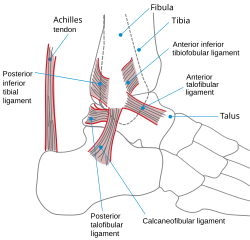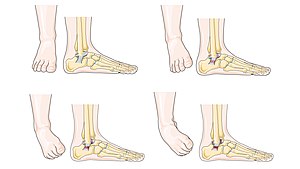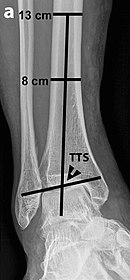Ankle
| Ankle | |
|---|---|
 Human ankle | |
 Lateral view of the human ankle | |
| Details | |
| Identifiers | |
| Latin | tarsus |
| MeSH | D000842 |
| TA98 | A01.1.00.041 |
| TA2 | 165 |
| FMA | 9665 |
| Anatomical terminology | |
Theankle,thetalocrural region[1]or thejumping bone(informal) is the area where thefootand thelegmeet.[2]The ankle includes threejoints:theankle joint properortalocrural joint,thesubtalar joint,and theinferior tibiofibular joint.[3][4][5]The movements produced at this joint are dorsiflexion andplantarflexionof the foot. In common usage, the term ankle refers exclusively to the ankle region. In medical terminology, "ankle" (without qualifiers) can refer broadly to the region or specifically to the talocrural joint.[1][6]
The main bones of the ankle region are thetalus(in the foot), thetibia,andfibula(both in the leg). The talocrural joint is asynovialhinge jointthat connects the distal ends of the tibia and fibula in the lower limb with the proximal end of the talus.[7]The articulation between the tibia and the talus bears more weight than that between the smaller fibula and the talus.
Structure
[edit]Region
[edit]The ankle region is found at the junction of thelegand thefoot.It extends downwards (distally) from the narrowest point of the lower leg and includes the parts of the foot closer to the body (proximal) to theheeland upper surface (dorsum) of the foot.[8]: 768
Ankle joint
[edit]The talocrural joint is the only mortise and tenon joint in the human body,[9]: 1418 the term likening the skeletal structure to thewoodworking jointof the same name. The bony architecture of the ankle consists of three bones: thetibia,thefibula,and thetalus.The articular surface of the tibia may be referred to as theplafond(Frenchfor "ceiling" ).[10]Themedial malleolusis a bony process extending distally off the medial tibia. The distal-most aspect of the fibula is called thelateral malleolus.Together, the malleoli, along with their supporting ligaments, stabilize the talus underneath the tibia.
Because the motion of the subtalar joint provides a significant contribution to positioning the foot, some authors will describe it as the lower ankle joint, and call the talocrural joint the upper ankle joint.[11]Dorsiflexion and Plantarflexion are themovementsthat take place in the ankle joint. When the foot is plantar flexed, the ankle joint also allows some movements of side to side gliding, rotation, adduction, and abduction.[12]
The bony arch formed by the tibial plafond and the two malleoli is referred to as the ankle "mortise"(or talar mortise). The mortise is a rectangular socket.[1]The ankle is composed of three joints: the talocrural joint (also called talotibial joint, tibiotalar joint, talar mortise, talar joint), thesubtalar joint(also called talocalcaneal), and theInferior tibiofibular joint.[3][4][5]The joint surface of all bones in the ankle is covered with articularcartilage.
The distances between the bones in the ankle are as follows:[13]
- Talus - medial malleolus: 1.70 ± 0.13 mm
- Talus - tibial plafond: 2.04 ± 0.29 mm
- Talus - lateral malleolus: 2.13 ± 0.20 mm
Decreased distances indicateosteoarthritis.
Ligaments
[edit]
The ankle joint is bound by the strongdeltoid ligamentand three lateral ligaments: theanterior talofibular ligament,theposterior talofibular ligament,and thecalcaneofibular ligament.
- Thedeltoid ligamentsupports the medial side of the joint, and is attached at themedial malleolusof the tibia and connect in four places to thetalar shelfof thecalcaneus,calcaneonavicular ligament,thenavicular tuberosity,and to the medial surface of the talus.
- Theanteriorandposterior talofibular ligamentssupport the lateral side of the joint from thelateral malleolusof the fibula to the dorsal and ventral ends of the talus.
- Thecalcaneofibular ligamentis attached at the lateral malleolus and to the lateral surface of the calcaneus.
Though it does not span the ankle joint itself, the syndesmotic ligament makes an important contribution to the stability of the ankle. This ligament spans thesyndesmosis,i.e. the articulation between the medial aspect of the distal fibula and the lateral aspect of the distal tibia. An isolated injury to this ligament is often called ahigh ankle sprain.
The bony architecture of the ankle joint is most stable indorsiflexion.[14]Thus, asprained ankleis more likely to occur when the ankle is plantar-flexed, as ligamentous support is more important in this position. The classic ankle sprain involves theanterior talofibular ligament(ATFL), which is also the most commonly injured ligament duringinversionsprains. Another ligament that can be injured in a severe ankle sprain is thecalcaneofibular ligament.
Retinacula, tendons and their synovial sheaths, vessels, and nerves
[edit]A number of tendons pass through the ankle region. Bands of connective tissue calledretinacula(singular:retinaculum) allow the tendons to exert force across the angle between the leg and foot without lifting away from the angle, a process called bowstringing.[11] Thesuperior extensor retinaculum of footextends between the anterior (forward) surfaces of the tibia and fibula near their lower (distal) ends. It contains theanterior tibial arteryandveinand the tendons of thetibialis anterior musclewithin its tendon sheath and the unsheathed tendons ofextensor hallucis longusandextensor digitorum longusmuscles. Thedeep peroneal nervepasses under the retinaculum while thesuperficial peroneal nerveis outside of it. Theinferior extensor retinaculum of footis a Y-shaped structure. Its lateral attachment is on the calcaneus, and the band travels towards the anterior tibia where it is attached and blends with the superior extensor retinaculum. Along with that course, the band divides and another segment attaches to theplantar aponeurosis.The tendons which pass through the superior extensor retinaculum are all sheathed along their paths through the inferior extensor retinaculum and the tendon of thefibularis tertius muscleis also contained within the retinaculum.
Theflexor retinaculum of footextends from the medial malleolus to the medical process of the calcaneus, and the following structures in order from medial to lateral: the tendon of thetibialis posterior muscle,the tendon of theflexor digitorum longus muscle,theposterior tibial arteryandvein,thetibial nerve,and the tendon of theflexor hallucis longus muscle.
Thefibular retinaculahold the tendons of thefibularis longusandfibularis brevisalong the lateral aspect of the ankle region. The superior fibular retinaculum extends from the deep transverse fascia of the leg and lateral malleolus to calcaneus. The inferior fibular retinaculum is a continuous extension from the inferior extensor retinaculum to the calcaneus.[9]: 1418–9
Mechanoreceptors
[edit]Mechanoreceptors of the ankle send proprioceptive sensory input to the central nervous system (CNS).[15]Muscle spindles are thought to be the main type of mechanoreceptor responsible for proprioceptive attributes from the ankle.[16]The muscle spindle gives feedback to the CNS system on the current length of the muscle it innervates and to any change in length that occurs.
It was hypothesized that muscle spindle feedback from the ankle dorsiflexors played the most substantial role inproprioceptionrelative to other muscular receptors that cross at the ankle joint. However, due to the multi-planar range of motion at the ankle joint there is not one group of muscles that is responsible for this.[17]This helps to explain the relationship between the ankle and balance.
In 2011, a relationship between proprioception of the ankle and balance performance was seen in the CNS. This was done by using a fMRI machine in order to see the changes in brain activity when the receptors of the ankle are stimulated.[18]This implicates the ankle directly with the ability to balance. Further research is needed in order to see to what extent does the ankle affect balance.
Function
[edit]Historically, the role of the ankle in locomotion has been discussed byAristotleandLeonardo da Vinci.There is no question that ankle push-off is a significant force inhuman gait,but how much energy is used in leg swing as opposed to advancing the whole-bodycenter of massis not clear.[19]
Clinical significance
[edit]
Traumatic injury
[edit]Of all major joints, the ankle is the most commonly injured. If the outside surface of the foot is twisted under the leg during weight bearing, thelateral ligament,especially theanterior talofibular portion,is subject to tearing (asprain) as it is weaker than the medial ligament and it resistsinward rotationof the talocrural joint.[8]: 825
Fractures
[edit]
Anankle fractureis a break of one or more of the bones that make up theankle joint.[20]Symptoms may include pain, swelling,bruising,and an inability to walk on the injured leg.[20]Complications may include an associatedhigh ankle sprain,compartment syndrome,stiffness,malunion,andpost-traumatic arthritis.[20][21]
Ankle fractures may result from excessive stress on the joint such as from rolling an ankle or fromblunt trauma.[20][21]Types of ankle fractures include lateralmalleolus,medial malleolus, posterior malleolus,bimalleolar,andtrimalleolar fractures.[20]TheOttawa ankle rulecan help determine the need for X-rays.[21]Special X-ray views called stress views help determine whether an ankle fracture is unstable.
Treatment depends on the fracture type. Ankle stability largely dictates non-operative vs. operative treatment. Non-operative treatment includes splinting or casting while operative treatment includes fixing the fracture with metal implants through an open reduction internal fixation (ORIF).[20]Significant recovery generally occurs within four months while completely recovery usually takes up to one year.[20]
Ankle fractures are common, occurring in over 1.8 per 1000 adults and 1 per 1000 children per year.[21][22]In North America this figure increases to more than 14 in ever 10,000 patients admitted to the Emergency Room.[23]They occur most commonly in young males and older females.[21]Imaging
[edit]The initial evaluation of suspected ankle pathology is usually byprojectional radiography( "X-ray" ).

Varus or valgus deformity, if suspected, can be measured with the frontal tibiotalar surface angle (TTS), formed by the mid-longitudinal tibial axis (such as through a line bisecting the tibia at 8 and 13 cm above the tibial plafond) and the talar surface.[24]An angle of less than 84 degrees is regarded astalipes varus,and an angle of more than 94 degrees is regarded astalipes valgus.[25]
For ligamentous injury, there are three main landmarks on X-rays: The first is thetibiofibular clear space,the horizontal distance from the lateral border of the posterior tibial malleolus to the medial border of the fibula, with greater than 5 mm being abnormal. The second istibiofibular overlap,the horizontal distance between the medial border of the fibula and the lateral border of the anterior tibial prominence, with less than 10 mm being abnormal. The final measurement is themedial clear space,the distance between the lateral aspect of the medial malleolus and the medial border of the talus at the level of the talar dome, with a measurement greater than 4 mm being abnormal. Loss of any of these normal anatomic spaces can indirectly reflect ligamentous injury or occult fracture, and can be followed by MRI or CT.[26]
Abnormalities
[edit]Clubfootor talipes equinovarus, which occurs in one to two of every 1,000 live births, involves multiple abnormalities of the foot.[27]Equinus refers to the downard deflection of the ankle, and is named for the walking on the toes in the manner of a horse.[28]This does not occur because it is accompanied by an inward rotation of the foot (varus deformity), which untreated, results in walking on the sides of the feet. Treatment may involve manipulation and casting or surgery.[27]
Ankle joint equinus, normally in adults, relates to restricted ankle joint range of motion(ROM).[29]Calf muscle stretching exercises are normally helpful to increase the ankle joint dorsiflexion and used to manage clinical symptoms resulting from ankle equinus.[30]
Occasionally a human ankle has aball-and-socket ankle jointand fusion of the talo-navicular joint.[31]
History
[edit]The word ankle or ancle is common, in various forms, toGermanic languages,probably connected in origin with theLatinangulus,orGreekαγκυλος,meaning bent.[32]
Other animals
[edit]
Evolution
[edit]It has been suggested that dexterous control of toes has been lost in favour of a more precise voluntary control of the ankle joint.[33]
See also
[edit]Footnotes
[edit]- ^abcMoore, Keith L.; Dalley, Arthur F.; Agur, A. M. R. (2013)."Lower Limb".Clinically Oriented Anatomy(7th ed.). Lippincott Williams & Wilkins. pp. 508–669.ISBN978-1-4511-1945-9.
- ^WebMD (2009)."ankle".Webster's New World Medical Dictionary(3rd ed.). Houghton Mifflin Harcourt. p. 22.ISBN978-0-544-18897-6.
- ^abMilner, Brent K. (1999)."Musculoskeletal Imaging".In Gay, Spencer B.; Woodcock, Richard J. (eds.).Radiology Recall.Lippincott Williams & Wilkins. pp.258–383.ISBN978-0-683-30663-7.
- ^abWilliams, D. S. Blaise; Taunton, Jack (2007)."Foot, ankle and lower leg".In Kolt, Gregory S.; Snyder-Mackler, Lynn (eds.).Physical Therapies in Sport and Exercise.Elsevier Health Sciences. pp. 420–39.ISBN978-0-443-10351-3.
- ^abdel Castillo, Jorge (2012)."Foot and Ankle Injuries".In Adams, James G. (ed.).Emergency Medicine.Elsevier Health Sciences. pp. 745–55.ISBN978-1-4557-3394-1.
- ^Gray, Henry (1918)."Talocrural Articulation or Ankle-joint".Anatomy of the Human Body.
- ^WebMD (2009)."ankle joint".Webster's New World Medical Dictionary(3rd ed.). Houghton Mifflin Harcourt. p. 22.ISBN978-0-544-18897-6.
- ^abMoore, Keith (2018).Clinically oriented anatomy.Philadelphia: Wolters Kluwer.ISBN978-1-4963-4721-3.
- ^abSusan Standring (7 August 2015).Gray's Anatomy E-Book: The Anatomical Basis of Clinical Practice.Elsevier Health Sciences.ISBN978-0-7020-6851-5.
- ^David P. Barei (29 March 2012)."56. Pilon Fractures".In Robert W. Bucholz (ed.).Rockwood and Green's Fractures in Adults: Two Volumes Plus Integrated Content Website (Rockwood, Green, and Wilkins' Fractures).Lippincott Williams & Wilkins. pp. 1928–1971.ISBN978-1-4511-6144-1.
- ^abJoseph E. Muscolino (21 August 2016).Kinesiology - E-Book: The Skeletal System and Muscle Function.Elsevier Health Sciences. pp. 284–292.ISBN978-0-323-39935-7.
- ^Joseph H Volker (2018-08-08)."Ankle Joint".Earth's Lab.
- ^Imai, Kan; Ikoma, Kazuya; Kido, Masamitsu; Maki, Masahiro; Fujiwara, Hiroyoshi; Arai, Yuji; Oda, Ryo; Tokunaga, Daisaku; Inoue, Nozomu; Kubo, Toshikazu (2015)."Joint space width of the tibiotalar joint in the healthy foot".Journal of Foot and Ankle Research.8(1): 26.doi:10.1186/s13047-015-0086-5.ISSN1757-1146.PMC4490633.PMID26146520.
- ^Gatt, A. and Chockalingam, N., 2011. Clinical Assessment of Ankle Joint DorsiflexionA Review of Measurement Techniques. Journal of the American Podiatric Medical Association, 101(1), pp.59-69.https://doi.org/10.7547/1010059
- ^Michelson, J. D.; Hutchins, C (1995)."Mechanoreceptors in human ankle ligaments".The Journal of Bone and Joint Surgery. British Volume.77(2): 219–24.doi:10.1302/0301-620X.77B2.7706334.PMID7706334.
- ^Lephart, S. M.; Pincivero, D. M.; Rozzi, S. L. (1998). "Proprioception of the ankle and knee".Sports Medicine.25(3): 149–55.doi:10.2165/00007256-199825030-00002.PMID9554026.S2CID13099542.
- ^Ribot-Ciscar, E; Bergenheim, M; Albert, F; Roll, J. P. (2003). "Proprioceptive population coding of limb position in humans".Experimental Brain Research.149(4): 512–9.doi:10.1007/s00221-003-1384-x.PMID12677332.S2CID14626459.
- ^Goble, D. J.; Coxon, J. P.; Van Impe, A.; Geurts, M.; Doumas, M.; Wenderoth, N.; Swinnen, S. P. (2011)."Brain Activity during Ankle Proprioceptive Stimulation Predicts Balance Performance in Young and Older Adults".Journal of Neuroscience.31(45): 16344–52.doi:10.1523/JNEUROSCI.4159-11.2011.PMC6633212.PMID22072686.
- ^Zelik, Karl E.; Adamczyk, Peter G. (2016)."A unified perspective on ankle push-off in human walking".The Journal of Experimental Biology.219(23): 3676–3683.doi:10.1242/jeb.140376.ISSN0022-0949.PMC5201006.PMID27903626.
- ^abcdefg"Ankle Fractures (Broken Ankle) - OrthoInfo - AAOS".www.orthoinfo.org.Retrieved20 June2019.
- ^abcdeWire J, Slane VH (9 May 2019)."Ankle Fractures".StatPearls.Treasure Island (FL): StatPearls Publishing.PMID31194464.
- ^Yeung DE, Jia X, Miller CA, Barker SL (April 2016)."Interventions for treating ankle fractures in children".The Cochrane Database of Systematic Reviews.2016(4): CD010836.doi:10.1002/14651858.CD010836.pub2.PMC7111433.PMID27033333.
- ^Ptak, Nathaniel A.; Rigby, Ryan B. (2024)."Subluxation of the posterior tibial tendon into the tibiofibular syndesmosis secondary to high-level ankle fracture or dislocation: Surgical reduction technique guide and case study".Foot & Ankle Surgery: Techniques, Reports & Cases.4(1): 100357.doi:10.1016/j.fastrc.2023.100357.ISSN2667-3967.
- ^Nosewicz, Tomasz L.; Knupp, Markus; Bolliger, Lilianna; Hintermann, Beat (2012)."The reliability and validity of radiographic measurements for determining the three-dimensional position of the talus in varus and valgus osteoarthritic ankles".Skeletal Radiology.41(12): 1567–1573.doi:10.1007/s00256-012-1421-6.ISSN0364-2348.PMC3478506.PMID22609967.
- ^Chapter 5 - Radiological morphology of peritalar instability in varus and valgus tilted ankles,in:T.L. Nosewicz (2018-09-25).Acute and chronic aspects of hindfoot trauma.University of Amsterdam, Faculty of Medicine (AMC-UvA).ISBN9789463750479.
- ^Evans, JM; Schucany, WG (October 2006)."Radiological evaluation of a high ankle sprain".Proceedings (Baylor University. Medical Center).19(4): 402–5.doi:10.1080/08998280.2006.11928206.PMC1618742.PMID17106502.
- ^abGore AI, Spencer JP (2004)."The newborn foot".Am Fam Physician.69(4): 865–72.PMID14989573.
- ^Källén, Bengt (2014). "Pes Equinovarus".Epidemiology of Human Congenital Malformations.pp. 111–113.doi:10.1007/978-3-319-01472-2_22.ISBN978-3-319-01471-5.
- ^Gatt, Alfred; Chockalingam, Nachiappan (2011-01-01). "Clinical Assessment of Ankle Joint Dorsiflexion".Journal of the American Podiatric Medical Association.101(1): 59–69.doi:10.7547/1010059.PMID21242472.
- ^Macklin, Katriona; Healy, Aoife; Chockalingam, Nachiappan (March 2012)."The effect of calf muscle stretching exercises on ankle joint dorsiflexion and dynamic foot pressures, force and related temporal parameters".The Foot.22(1): 10–17.doi:10.1016/j.foot.2011.09.001.PMID21944945.
- ^Ono, K.; Nakamura, M.; Kurata, Y.; Hiroshima, K. (September 1984). "Ball-and-socket ankle joint: Anatomical and kinematic analysis of the hindfoot".Journal of Pediatric Orthopedics.4(5): 564–568.doi:10.1097/01241398-198409000-00007.PMID6490876.
- ^Chisholm, Hugh,ed. (1911)..Encyclopædia Britannica.Vol. 2 (11th ed.). Cambridge University Press. p. 58.
- ^Brouwer, B.; Ashby, P. (1992). "Corticospinal projections to lower limb motoneurons in man".Experimental Brain Research.89(3): 649–54.doi:10.1007/bf00229889.PMID1644127.S2CID24650165.
References
[edit]- Anderson, Stephen A.; Calais-Germain, Blandine (1993).Anatomy of Movement.Chicago: Eastland Press.ISBN978-0-939616-17-6.
- McKinley, Michael P.; Martini, Frederic; Timmons, Michael J. (2000).Human Anatomy.Englewood Cliffs, N.J: Prentice Hall.ISBN978-0-13-010011-5.
- Marieb, Elaine Nicpon (2000).Essentials of Human Anatomy and Physiology.San Francisco: Benjamin Cummings.ISBN978-0-8053-4940-5.
Additional images
[edit]-
Dorsum of Foot. Ankle joint. Deep dissection.
-
Dorsum of Foot. Ankle joint. Deep dissection.
-
Ankle joint. Deep dissection. Anterior view.
-
Dorsum of Foot. Ankle joint. Deep dissection.
External links
[edit]- Ardizzone, Remy; Valmassy, Ronald L. (October 2005)."How To Diagnose Lateral Ankle Injuries".Podiatry Today. Archived fromthe originalon January 4, 2010.RetrievedSeptember 21,2017.
- Haddad, Steven L. (ed.)."Foot & Ankle".Your orthopaedic connection (American Academy of Orthopaedic Surgeons).Archivedfrom the original on 23 March 2010.RetrievedSeptember 21,2017.




